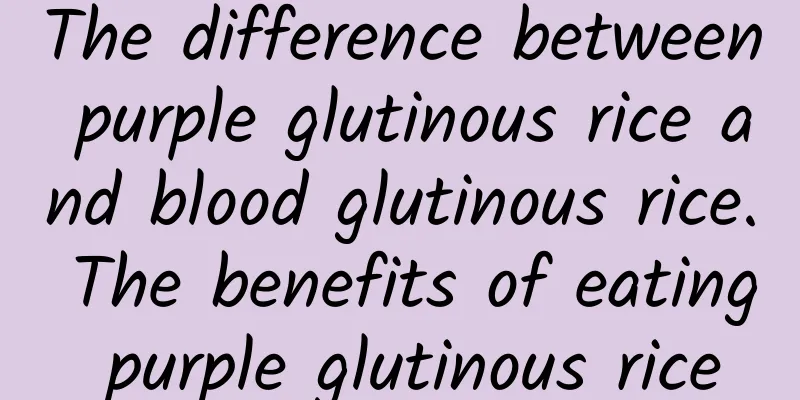The difference between purple glutinous rice and blood glutinous rice. The benefits of eating purple glutinous rice

|
Purple glutinous rice is a very common ingredient in life. It is suitable for cooking porridge and can also be used to make various pastries and desserts. It tastes especially good when it is done. However, there is also a kind of blood glutinous rice on the market, which looks similar to purple glutinous rice. Many people want to know the difference between the two. Today I will give a detailed introduction to purple glutinous rice and blood glutinous rice, so that everyone can understand the difference between the two and the benefits of eating purple glutinous rice. The difference between purple glutinous rice and blood glutinous riceThere is not much difference between purple glutinous rice and blood glutinous rice. It should be said that blood glutinous rice is a kind of purple glutinous rice, because their appearance is dark purple, and when soaked in clean water, the water will turn into blood-like red, so people call it blood glutinous rice. However, in addition to this blood glutinous rice that is purple inside and out, there is also a kind of glutinous rice that is purple outside and white inside. That kind of glutinous rice has less stickiness and a slightly worse taste, so it cannot be called blood glutinous rice. The benefits of eating purple glutinous rice1. Nutritional supplement Supplementing the body with beneficial nutrients, maintaining normal metabolism and improving the functions of multiple organs are important benefits of eating glutinous rice. Purple glutinous rice is a highly nutritious food. It not only contains a large amount of carbohydrates and plant protein, but also contains amino acids and a variety of minerals. It can meet the different nutritional needs of the human body during normal work and can improve the functions of all organs. 2. Blood supplement People who eat more purple glutinous rice can also improve the body's hematopoietic function and relieve the body's qi and blood deficiency. It can play a particularly good role in blood supplementation and is suitable for patients with insufficient qi and blood and qi and blood deficiency. In addition, when people suffer from iron deficiency anemia, eating more purple glutinous rice can also gradually alleviate the symptoms. 3. Nourishing the kidneys Nourishing the kidneys is also an important benefit of eating purple glutinous rice. Can eating purple glutinous rice improve kidney function and relieve insufficient kidney qi? It has a particularly good effect in alleviating symptoms such as soreness of the waist and knees, dizziness, tinnitus, and memory loss caused by kidney deficiency and insufficient kidney qi. Regular consumption can maintain human kidney health and improve the body's health level. Today I will show you the difference between purple glutinous rice and blood glutinous rice, so that you can understand the difference between the two, and also let you know the benefits of eating purple glutinous rice. In the future, you can eat purple glutinous rice with confidence when you need it, but if you want to nourish your body with purple glutinous rice, you still have to choose blood glutinous rice among the purple glutinous rice. Its edible effects are better than ordinary glutinous rice. |
<<: The efficacy and function of purple rice and purple glutinous rice
>>: The efficacy, effects and contraindications of purple glutinous rice
Recommend
The efficacy and function of soybean milk
Soybean milk is a white liquid made by grinding s...
How is AU? AU reviews and website information
What is the AU website? The African Union (AU) is ...
What is Knight Frank Kenya like? Knight Frank Kenya real estate agency reviews and website information
What is the website of Knight Frank Kenya? Knight ...
What are the effects of drinking aphrodisiac fruit wine?
Aphrodisiac fruit, also known as kidney-tonifying...
The efficacy and function of super seedless grapes
Have you ever seen super seedless grapes? Do you ...
The efficacy, effects and contraindications of ancient brown sugar
Ancient recipe brown sugar can be said to be a hi...
The benefits of eating Hami melon
Hami melon is a nutritious and economical fruit. ...
Potato and eggplant stew
Potatoes and eggplants are my favorite vegetables...
How is the How to Study Network? How to Study Network Reviews and Website Information
What is How to Study? How to Study is a website in...
Can you eat sprouted sweet potatoes? What are the harms of eating sprouted sweet potatoes?
Tomatoes, also known as sweet potatoes, are a fav...
The benefits of eating chicken liver
Chicken liver is the liver of a chicken. It is a ...
What vegetables can lower blood sugar? What foods can lower blood sugar?
Are there any vegetables that can lower blood sug...
What are the effects of cinnamon wine? What are the effects and functions of cinnamon wine?
Cinnamon is a spice that people are very familiar...
How to make delicious pumpkin porridge How to make delicious pumpkin porridge
Pumpkin porridge is the most common health-preser...
The efficacy and method of stewing loquat with rock sugar
Loquat stewed with rock sugar is a dessert that m...









